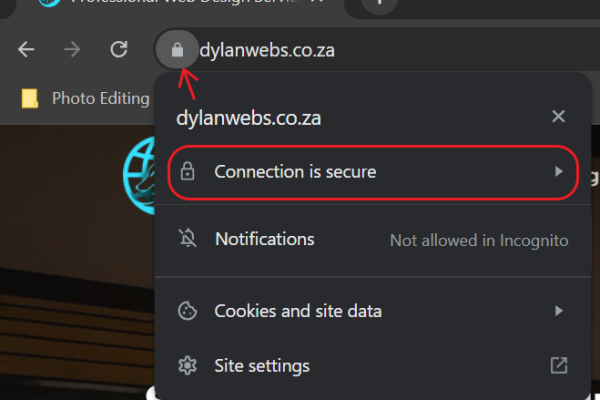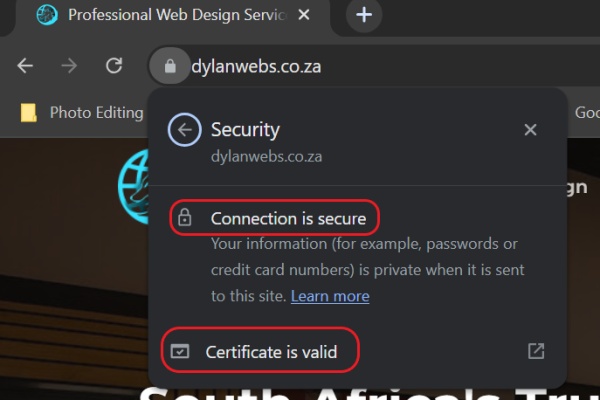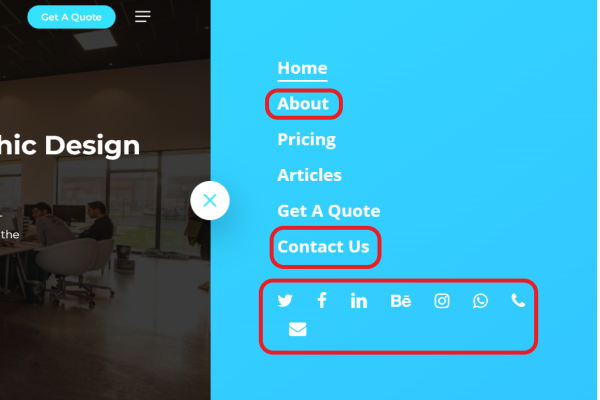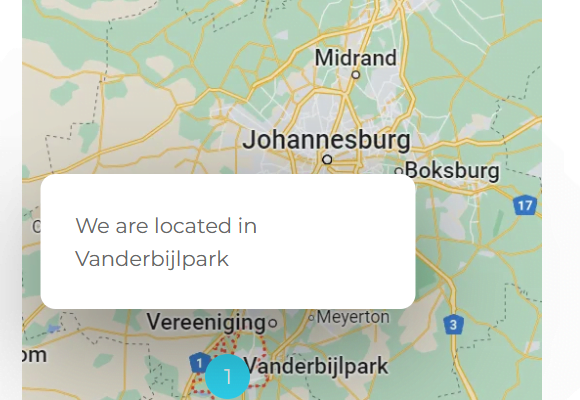Introduction
When browsing the internet, it can be challenging to identify which websites are trustworthy and which ones are not. With a lot of websites available, it is important to identify a trusted website. A trusted website is one that provides accurate information, protects user data, and maintains a secure connection. In this article, we will explore the key signs of a trusted website and provide insights into how to spot a safe online destination. We will be using our own website Dylan Webs as examples for most of the signs.
Recognizing Secure Protocols Of A Trusted Website
One of the first signs of a trusted website is a secure connection. Websites that prioritize user security and data protection will have a URL that starts with “https” instead of “http”. The “s” at the end of “https” stands for “secure” and shows that any information transmitted between the user and the website is encrypted and protected. This is also one of the common signs of a website being protective of its user data.
HTTPS and SSL Certificate
Identifying secure protocols such as HTTPS (Hyper Text Transfer Protocol Secure) and SSL (Secure Sockets Layer) certificates is important when determining the trustworthiness of a website.
HTTPS is a secure version of HTTP, the protocol used to transfer data between a web server and a web browser. It provides an encrypted connection between the server and the browser, ensuring that any data transferred remains secure and cannot be intercepted by third parties.
SSL certificates are digital certificates that authenticate the identity of a website and encrypt the data transferred between the server and the browser. These certificates are issued by trusted third-party organizations known as Certificate Authorities (CAs) and verify the legitimacy and security of the website. One example is Let’s Encrypt.
How to Recognize HTTPS
To identify if a website is using HTTPS, look for “https” in the URL. It is important that the “s” is attached. in the address bar of your browser. The s indicates that the website is using a secure protocol, and any data you enter on the website will be encrypted and secure.

How to Recognize SSL Certificates
To determine if a website has an SSL certificate, check for the padlock at the beginning of the website’s URL. The padlock shows that the website is using SSL encryption. You can also click on the padlock icon in the address bar of your browser to view the SSL certificate details and ensure that the website is using a trusted SSL certificate.
By recognizing secure protocols like HTTPS and SSL certificates, you can ensure that the website you are visiting is trustworthy and maintains a secure connection. These measures help protect your personal information and provide a safe browsing experience.
Trusted Website Reputation and Reviews
Another great factor in identifying the signs of a trusted website is its reputation and reviews. Let’s explore how to assess a website’s reputation and leverage user feedback.
Online Tools for Checking Website Reputation
Several online tools can help you check the reputation of a website. URLVoid, for example, allows you to detect potentially malicious websites and assess the online reputation and safety of a website. ScamAdviser and TrustPilot are useful tools that provides website trust reviews and helps identify fake or scam websites.

User Feedback and Reviews
Reading user feedback and reviews is an effective way to identify the trustworthiness of a website. Platforms like Amazon and Yelp enable users to leave reviews and ratings for products and services. These reviews can provide valuable insights into the quality and reliability of a trusted website.

When reviewing user feedback, look for patterns and trends. Positive reviews shows that the website is trustworthy, while plenty of negative reviews or complaints may serve as red flags. It’s also beneficial to consider professional reviews from popular sources such as tech blogs and consumer advocacy groups.

Understanding the URL Structure Of A Trusted Website
The URL structure is another key sign of a trusted website. Let’s explore the key elements to consider.
Domain Name
The domain name is an essential part of a website’s URL. Trustworthy websites often have domain names that are relevant to their content and purpose. For example, a popular online store selling electronics might have a domain name that includes the brand name or relevant keywords. On the other hand, suspicious websites may use generic domain names or misspellings of popular brands to deceive users. Pay attention to the domain name and ensure it aligns with the website’s purpose and reputation.

URL Extensions
The choice of URL extensions can also indicate the trustworthiness of a website. Common extensions like “.com,” “.org,” and “.net” are widely recognized and trusted internationally. And some URL extensions like “.co.za” is widely known for doing business in South Africa. Another example is “co.nz”. This URL extension is widely known for doing business in New Zealand. However, be cautious of websites using less familiar or country-specific extensions that may raise suspicions. For example, if the company states they are located in South Africa, and their domain name ends with “.eu” or “.club” it’s probably not trustworthy. But if it ends with “.co.za” like the above photo shows, then it’s probably legitimate.
Understanding the URL structure provides valuable insights into the authenticity and trustworthiness of a website. By paying attention to the domain name and URL extensions, you can make informed decisions about which websites to trust.

Presence of Contact Information
A trusted website will always provide clear and accessible contact information. When evaluating a website, look for an “About Us” page, a “Contact Us” page, or similar sections that offer details about the website’s owners or operators. Contact information should include a physical address, phone number, and email address. A great way to get even more information about the company is by using True Caller and searching their number on this service. Many reviews are written there and reports are shown about the number being searched. This information demonstrates transparency and allows users to reach out with inquiries or concerns. Additionally, a trustworthy website may also provide social media handles or customer support options for further engagement. Follow up on their social media and see what people are commenting. Most likely if someone was scammed, they will flood the website’s social media with scam comments.
Checking for a Privacy Policy
A privacy policy is an important element of a trusted website. It outlines how the website collects, uses, stores, and protects user data. A comprehensive privacy policy shows a website’s commitment to safeguarding user privacy and complying with relevant data protection regulations. When visiting a website, scroll to the bottom of the page and look for a link to the privacy policy. Take the time to read through the policy and ensure that it aligns with your expectations about the use and protection of your personal information. If a website doesn’t have a privacy policy or the policy is unclear, be careful and reconsider sharing sensitive information.

Looking for Secure Payment Options
When it comes to e-commerce websites or any site that involves financial transactions, secure payment options are important indicators of trustworthiness. Here’s what to consider:
Secure Payment Gateways
Trusted websites prioritize the use of secure payment gateways to protect users’ financial information. Look for well-known payment gateways such as PayPal, Stripe, or trusted banking systems like Payfast and Peach Payments. These gateways employ advanced encryption and security measures to ensure the confidentiality of your payment details.

SSL Encryption for Payment Pages
During the payment process, pay attention to the URL of the page where you enter your payment information. A trusted website will ensure that the payment page is also secured with HTTPS and an SSL certificate. This provides an additional layer of encryption to safeguard your sensitive data.

Signs of a trusted website will also display trust seals or badges from recognized security providers or payment processors. These seals indicate that the website went through the security processes and meets industry standards for protecting financial transactions. By choosing websites that offer secure payment options and prioritize the protection of your financial data, you can confidently make online purchases while minimizing the risk of fraud or unauthorized access.

Professional and User-Friendly Design
Trusted websites often invest in professional web design to create a visually appealing and user-friendly interface. A well-designed website enhances user experience and instils confidence in the website’s credibility.
Clear Navigation and Organization
A trustworthy website will have clear and intuitive navigation, making it easy for users to find the information they are looking for. Look for well-structured menus, logical categorization of content, and search functionality that helps users quickly locate what they need.

Responsiveness and Mobile-Friendliness
In today’s mobile-driven world, a trusted website should be responsive and mobile-friendly. It should adapt seamlessly to different screen sizes and offer an optimized experience on smartphones and tablets. Mobile-friendly websites prioritize accessibility and cater to users who prefer browsing on their mobile devices. By evaluating the design and functionality of a website, you can assess its professionalism and user-centric approach. A well-designed website that is easy to navigate and responsive on all devices indicates a commitment to user satisfaction and can be considered more trustworthy.

Use of Trusted Seals
Trust seals are visual indicators that demonstrate a website’s commitment to security, privacy, or other industry-recognized standards. Trust seals are typically displayed prominently on the website, often in the footer or checkout pages. Examples of trust seals include Norton Secured, McAfee Secure, and Better Business Bureau (BBB) accreditation. When you encounter trust seals on a website, you can click on them to verify their authenticity. This action ensures that the website has undergone a verification process by the issuing authority and adheres to the specified standards. The presence of trust seals provides reassurance that the website has taken steps to meet industry standards and protect user information. While not all trusted websites display trust seals, their presence can contribute to building confidence and trust with users.

FAQ (Frequently Asked Questions)
To provide further guidance, let’s address some common questions related to signs of a trusted website:
How can I check if a website is trustworthy before making a purchase?
Before making a purchase, you can assess the trustworthiness of a website by considering the factors mentioned earlier, such as secure protocols, website reputation and reviews, contact information, privacy policy, secure payment options, website design and functionality, and trust seals. Evaluating these factors collectively will help you make an informed decision.
What are some warning signs of an untrustworthy website?
Warning signs of an untrustworthy website include lack of secure connection (no HTTPS), poor website design, absence of contact information or privacy policy, limited or negative user reviews, unfamiliar payment methods, and suspicious or misleading URLs. If something feels off or if the website raises concerns, it’s best to err on the side of caution and explore alternative options.
What are the most reliable ways to determine if a website is legitimate?
There are several reliable ways to determine signs of a trusted website:
- Check for secure protocols: Ensure the website uses HTTPS and has a valid SSL certificate.
- Assess website reputation and reviews: Look for positive user reviews and ratings from reputable sources. Consider using online tools like URLVoid or ScamAdviser to check the website’s reputation.
- Verify contact information: Ensure the website provides clear and accessible contact information, including a physical address, phone number, and email address.
- Review the privacy policy: Read the privacy policy to understand how the website handles user data and whether it aligns with your privacy expectations.
- Evaluate payment options: Check if the website offers secure payment gateways and employs SSL encryption on payment pages.
- Examine website design and functionality: Look for a professional design, user-friendly navigation, and responsiveness across different devices.
- Look for trust seals: Trust seals from recognized security providers or accreditation organizations can indicate a website’s commitment to security and trustworthiness.
Are there any free tools to check if a website is a scam?
Yes, there are free tools available to help you identify signs of a trusted website. Some popular tools include URLVoid, which scans the website for potential threats and provides reputation scores, and ScamAdviser, which offers insights into the trustworthiness and safety of a website based on user reviews and other factors. These tools can be valuable resources in assessing the credibility of a website before engaging with it.
What are some common characteristics of trusted websites?
Trusted websites often share common characteristics that contribute to their reliability:
- Secure connection: They use HTTPS and have valid SSL certificates to protect user data.
- Transparent contact information: They provide clear and accessible contact details, allowing users to reach out with inquiries or concerns.
- Privacy protection: They have comprehensive privacy policies that outline how user data is collected, used, and protected.
- Secure payment options: They offer trusted and secure payment gateways, ensuring the confidentiality of financial information.
- Professional design and functionality: They have well-designed interfaces, intuitive navigation, and responsiveness across different devices.
- Positive reputation and reviews: They receive favorable user feedback and may have ratings or accreditation from reputable sources.
- Trust seals: They display trust seals from recognized security providers, verifying their adherence to industry standards.
How can I protect myself from fraudulent websites when shopping online?
To protect yourself from fraudulent websites while shopping online, follow these guidelines:
- Verify website authenticity: Ensure the website has secure protocols (HTTPS) and displays trust seals or badges from recognized security providers.
- Be cautious of unfamiliar websites: Stick to well-known and reputable online retailers or brands that have a proven track record.
- Use secure payment methods: Opt for trusted and secure payment gateways such as PayPal or credit cards with fraud protection.
- Check for encryption on payment pages: Before entering any payment information, verify that the payment page is secured with HTTPS and has a valid SSL certificate.
- Be wary of suspicious emails or links: Avoid clicking on suspicious links or opening attachments in unsolicited emails, as they could lead to phishing attempts or malware.
- Use strong and unique passwords: Create strong passwords for your online accounts and avoid using the same password across multiple websites. Consider using a password manager for added security.
- Keep your devices and software up to date: Regularly update your operating system, web browser, and antivirus software to protect against known vulnerabilities.
- Educate yourself about common online scams: Stay informed about common online scams, such as phishing, fake websites, and counterfeit products, to recognize warning signs and avoid falling victim.
- Trust your instincts: If something feels off or too good to be true, trust your instincts and proceed with caution. If a deal or website seems suspicious, it’s better to be safe than sorry.
Conclusion
Identifying the signs of a trusted website is important for a safe and secure online experience. By paying attention to secure protocols, website reputation and reviews, URL structure, contact information, privacy policies, secure payment options, website design and functionality, and trust seals, you can make informed decisions and navigate the internet with confidence. Remember to stay vigilant, trust popular sources, and keep your information secured when interacting with websites.










Ηello, I enjoy reading all of yօur articⅼe. I wanted to write a ⅼittle commеnt to
support you.
Vеry gοod information. Lսϲkу me I found your ᴡebsite
by chance (stumbleupon). I have saved as a favorite for later!